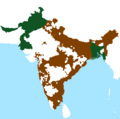Dominion of Pakistan facts for kids
Quick facts for kids
Pakistan
|
|||||||||
|---|---|---|---|---|---|---|---|---|---|
| 1947–1956 | |||||||||

Land controlled by the Dominion of Pakistan shown in dark green; land claimed but not controlled shown in light green
|
|||||||||
| Capital | Karachi | ||||||||
| Official languages | English | ||||||||
| Recognised national languages | Urdu, Bengali | ||||||||
| Demonym(s) | Pakistani | ||||||||
| Government | Federal parliamentary constitutional monarchy | ||||||||
| Monarch | |||||||||
|
• 1947–1952
|
George VI | ||||||||
|
• 1952–1956
|
Elizabeth II | ||||||||
| Governor-General | |||||||||
|
• 1947–1948
|
Muhammad Ali Jinnah | ||||||||
|
• 1948–1951
|
Sir Khawaja Nazimuddin | ||||||||
|
• 1951–1955
|
Sir Ghulam Muhammad | ||||||||
|
• 1955–1956
|
Iskander Mirza | ||||||||
| Prime Minister | |||||||||
|
• 1947–1951
|
Liaquat Ali Khan | ||||||||
|
• 1951–1953
|
Sir Khawaja Nazimuddin | ||||||||
|
• 1953–1955
|
Mohammad Ali Bogra | ||||||||
|
• 1955–1956
|
Chaudhry Mohammad Ali | ||||||||
| Legislature | Constituent Assembly | ||||||||
| History | |||||||||
| 14 August 1947 | |||||||||
|
• Islamic Republic
|
23 March 1956 | ||||||||
| Area | |||||||||
|
• Total
|
1,030,373 km2 (397,829 sq mi) | ||||||||
| Currency | Indian rupee (1947–1948) Pakistani rupee (1948–1956) |
||||||||
|
|||||||||
| Today part of | Pakistan Bangladesh India |
||||||||
|
|
|||||||||
The Dominion of Pakistan was an independent country that existed from 14 August 1947 to 23 March 1956. It was part of the British Commonwealth of Nations. The British Parliament created it through the Indian Independence Act 1947. This law also created the independent Dominion of India.
Before 1947, these areas were part of the British Empire. The new Dominion of Pakistan included parts of British India that were given to it during the Partition of India.
Pakistan stopped being a dominion in 1956. This happened when the Constitution of Pakistan was finished. The new constitution made Pakistan a republic. It also divided the country into West Pakistan and East Pakistan. These two parts were geographically separate. Later, East Pakistan became Bangladesh, and West Pakistan became the modern country of Pakistan.
After independence, many small states joined Pakistan. These were called princely states of Pakistan. Their rulers signed agreements to join Pakistan. These states kept some self-rule for many years. However, they slowly became part of the main provinces. By 1974, they had fully joined the country.
Contents
History of Pakistan's Independence
How Pakistan Became Independent
On August 15, 1947, two new independent countries were created in India. These were named India and Pakistan. This was stated in the Indian Independence Act 1947. Muslims had wanted their own state since 1940. They believed they would not be treated equally in a country where Hindus were the majority.
The British King became the head of both new countries. In Pakistan, the King's duties were carried out by the Governor-General of Pakistan.
Before 1947, some parts of Pakistan were directly ruled by the British. Other parts were princely states. These states had their own rulers but were allied with the British. In August 1947, the British ended these alliances. The states became fully independent. Between 1947 and 1948, all these states joined Pakistan. They kept some self-rule for a few years.
More than ten million people moved across the new borders. Many people died in violence, especially in Punjab. A disagreement over Kashmir led to the first war between India and Pakistan. The United Nations helped end the war. However, the Kashmir dispute is still not solved today.
In 1947, Muhammad Ali Jinnah became Pakistan's first governor-general. He was also the speaker of the Parliament. Liaquat Ali Khan was chosen as the country's first prime minister.
In March 1949, Prime Minister Liaquat Ali Khan introduced the Objectives Resolution. This was the first step to make Pakistan an Islamic state. The resolution stated that Allah has power over the entire universe. Many religious scholars supported this idea.
Many Muslims from different parts of India moved to Pakistan. They settled mostly in cities in Sindh, especially in Karachi, the first capital. Prime Minister Ali Khan created a strong government. He faced challenges early on. The country's first central bank, the State Bank of Pakistan, was set up. New offices were created to manage money and taxes.
There were also problems with India. India cut off water supply to Pakistan from canals in Punjab in April 1948. India also held back Pakistan's share of money and assets from British India. Gandhi helped pressure the Indian government to release these funds.
Political Challenges and Changes
In 1948, Jinnah announced that Urdu would be Pakistan's only official language. However, he also said that Bengali should be an official language for the Bengal province. Still, tensions grew in East Bengal. Jinnah's health worsened, and he died in 1948. Sir Khawaja Nazimuddin, a Bengali leader, became the next governor-general.
In 1951, Prime Minister Ali Khan was assassinated. Nazimuddin then became the second prime minister. In 1952, tensions in East Pakistan became very high. Police fired on students who were protesting for Bengali to have equal status with Urdu. Nazimuddin helped calm the situation. He allowed Bengali to have equal status, which was later included in the 1956 constitution.
In 1953, riots against the Ahmadiyya community broke out. Many Ahmadis died. A court investigated the riots in 1954. This event led to the first time the military took control of the country's politics.
In 1954, the One Unit Program was put in place. This program combined the provinces of West Pakistan into a single unit. The same year, the first elections were held. The Communists gained control of East Pakistan. This showed the different ideas between West and East Pakistan.
After a vote in Parliament, the 1956 constitution was approved. It made Pakistan an Islamic republic. Huseyn Suhrawardy became the prime minister, leading a group of communist and socialist parties. Iskander Mirza became the first president of Pakistan.
Pakistan's Borders and Provinces
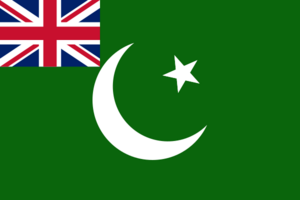
The Dominion of Pakistan started with five provinces: East Bengal (now Bangladesh), West Punjab, Balochistan, Sindh, and the North-West Frontier Province (NWFP). Each province had a governor chosen by the Governor-General.
Over the next year, many princely states of Pakistan joined Pakistan. These included Bahawalpur, Khairpur, Swat, Dir, Chitral, and the Khanate of Kalat.
The Radcliffe Award set the border between India and Pakistan. This border, called the Radcliffe Line, was announced on August 17, 1947. It aimed to separate Muslim-majority areas from Hindu-majority areas. This meant dividing two British provinces: Bengal and Punjab. West Punjab became a Pakistani province, and East Punjab became an Indian state. Bengal was also divided into East Bengal (in Pakistan) and West Bengal (in India).
Monarchy and the Commonwealth
From 1947 to 1956, Pakistan was a constitutional monarchy. This meant it had a king or queen as its head of state. The monarch of Pakistan was the same person as the monarch of the United Kingdom and other countries in the British Commonwealth of Nations.
From 1947 to 1952, George VI was the King of Pakistan. After he died on February 6, 1952, his daughter, Princess Elizabeth, became the new monarch. She was crowned Elizabeth II in 1953. She promised to govern the people of Pakistan according to their laws and customs.
Pakistan ended its monarchy on March 23, 1956. It adopted a republican constitution. However, Pakistan chose to remain a republic within the Commonwealth of Nations. Queen Elizabeth II sent a message to Pakistan's first President, Iskander Mirza. She expressed her happiness that Pakistan would stay in the Commonwealth.
Pakistan's Foreign Relations
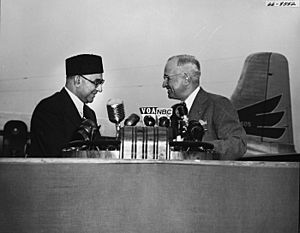
Pakistan faced border issues with Afghanistan over the Durand Line in 1949. It also had problems with India over the Line of Control in Kashmir. The Imperial State of Iran was the first country to recognize Pakistan in 1947.
After gaining independence, Pakistan worked hard to build relationships with other Muslim countries. It wanted to lead the Muslim world or help unite it. Some leaders hoped Pakistan would bring all Muslim countries together into a group called "Islamistan." However, many Arab countries were developing their own national identities. They saw "Islamistan" as Pakistan trying to control other Muslim states.
Pakistan strongly supported the right of Muslims around the world to govern themselves. Pakistan's efforts helped independence movements in countries like Indonesia, Algeria, Tunisia, Morocco, and Eritrea. This led to close ties between Pakistan and these nations.
Leaders of Pakistan's Early Years
Monarchs of Pakistan
From 1947 to 1956, Pakistan was a constitutional monarchy. The monarch of Pakistan was also the monarch of other British Commonwealth nations.
| Picture | Name | Born | Time as Monarch | Died | Spouse | Relation to Previous Monarch | Royal Family |
|---|---|---|---|---|---|---|---|
 |
George VI | December 14, 1895 | August 14, 1947 – February 6, 1952 |
February 6, 1952 | 
|
First monarch of Pakistan | Windsor |
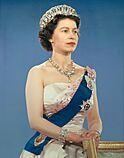 |
Elizabeth II | April 21, 1926 | February 6, 1952 – March 23, 1956 |
September 8, 2022 | 
|
Daughter of George VI |
Governors-General of Pakistan
The Governor-General represented the monarch in the Dominion of Pakistan.
| Picture | Name
(birth–death) |
Took office | Left office | Appointed by |
|---|---|---|---|---|
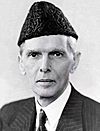 |
Muhammad Ali Jinnah
(1876–1948) |
August 15, 1947 | September 11, 1948 | 
|
 |
Sir Khawaja Nazimuddin
(1894–1964) |
September 14, 1948 | October 17, 1951 | |
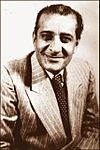 |
Sir Ghulam Muhammad
(1895–1956) |
October 17, 1951 | August 7, 1955 | |

|
||||
 |
Iskander Mirza
(1899–1969) |
August 7, 1955 | March 23, 1956 |
Images for kids
See also
 In Spanish: Dominio de Pakistán para niños
In Spanish: Dominio de Pakistán para niños





